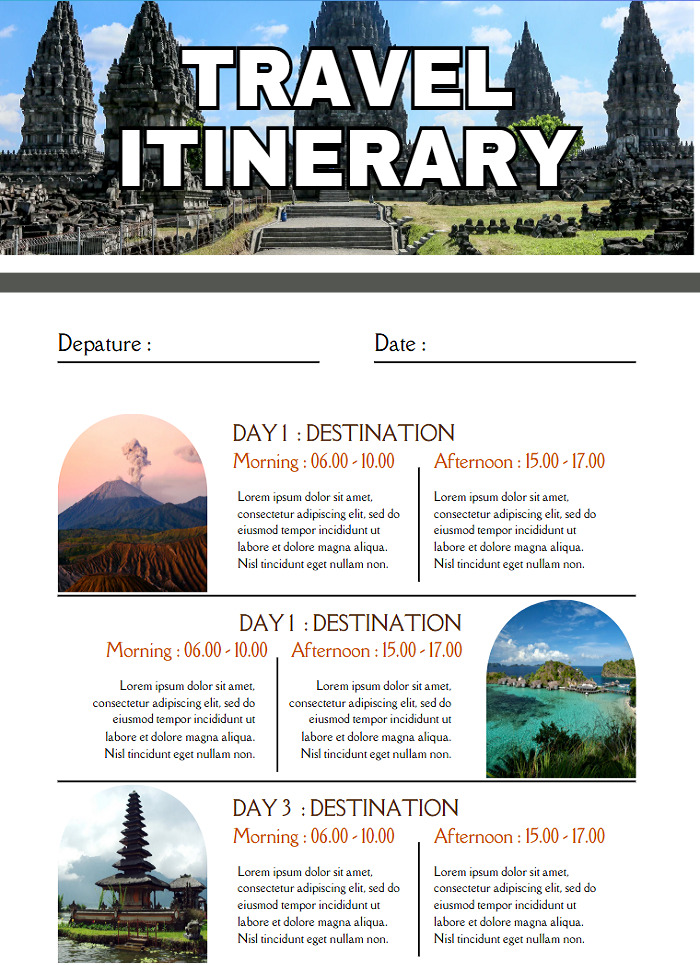In 2024, global tourism came roaring back with 1.4 billion international arrivals—and 2025 is shaping up to be even stronger. As travelers return in record numbers and spend more than ever, destinations of all sizes have a unique opportunity to capture their attention.
And it’s not just hotels and tour operators that can benefit. Museums, local shops, nature parks, and cultural spots can all stand out—especially with the help of a well-designed digital travel brochure. In this article, we’ll show you how to make travel brochures and guides for any tourist attraction, helping you reach visitors before they even pack their bags.
What Is a Travel Brochure?
A travel brochure is a promotional material that advertises a destination, sightseeing attraction, or tour activity. Brochures can both inspire tourists to plan a trip as well as educate them about sights to see and things to do after they’ve arrived at their place of interest.
As far as brochure format is concerned, we would recommend you to create both printed and online travel brochures to suit the needs of a wider variety of clients. For instance, some of the tourists will prefer looking through your printed brochures right at your office. And others will want to receive an online pamphlet from you or just find it on the web and explore it comfortably at home.
Creating travel brochures online will bring you numerous fresh opportunities for presenting content:
- Give you a competitive edge with interactive engaging features, such as realistic page flip effect, videos, GIFs, pop-ups and image galleries, forms and quizzes, and outbound links. You’ll be able to create a fully immersive reading experience with your brochure and get more bookings and sales.
- Allow you to raise your brand awareness by customizing your brochure with company colors, adding a logo, favicon, and unique background.
- Help you share your content easily via a direct link. Plus, you can embed a travel pamphlet into your website, share on social media or via a QR code.
See how enticing a travel brochure example, made with a travel brochure maker, can look.
Want to craft a stunning travel brochure?
💡 If you want to make an online travel pamphlet but don't have a PDF yet, we've got you covered. Check out these free brochure Canva templates that you can design and then get back to FlippingBook for creating travel brochures right away. What's more, FlippingBook has a convenient integration with Canva that allows you to seamlessly proceed from designing a PDF in Canva to publishing your PDF to FlippingBook, where you can customize it and make it fun and interactive.
|
|
|
🗺️ Need to create a travel itinerary brochure?
An itinerary brochure is a handy guide that outlines the key details of a trip—think schedules, destinations, activities, and must-see spots—all in one easy-to-share format. Explore these free Canva itinerary templates that you can easily personalize with your travel plans and then turn into interactive brochures with FlippingBook.
Check out how one of our clients describes why FlippingBook’s brochures stand out and then read on to learn all the details.
🌟 Curious how a digital travel brochure can elevate your content?
Flip through this example to see how FlippingBook transforms static PDFs into engaging, interactive guides that inspire travelers from the first page.
Bring Travel to Life with FlippingBook
Main Elements to Include in Your Travel Pamphlet
When making a travel brochure or a digital travel guide, it is important to include the following elements to make it the most efficient:
🏖️Destination information: provide details about the location, including its history, culture, attractions, and activities.
🖼️Stunning imagery: include high-quality photos that showcase the beauty of the destination and entice readers to visit.
🗺️Detailed map: add a map that highlights key landmarks, attractions, and points of interest in the area.
🏨Accommodation options: provide information about different lodging options available, such as hotels, resorts, and vacation rentals.
✈️Transportation information: include details about how to get to the destination, such as information about airports, train stations, and public transportation options.
🏛️Activities and excursions: describe popular activities and excursions available in the area, such as sightseeing tours, outdoor adventures, and cultural experiences.
🥂Dining options: include information about local cuisine, popular restaurants, and dining experiences in the area.
💱Travel tips: provide practical tips for travelers, such as currency exchange rates, local customs, and safety precautions.
ℹ️ Contact information: include contact details for local tourism offices, hotels, tour operators, and other relevant businesses.
💜Call to action: encourage readers to book their trip by including a call to action, such as a special offer or discount code.
There can be different types of travel brochures: destination, tour, theme park, and more. But one of the most popular types is a cruise brochure. So if you’re creating such a travel pamphlet, make sure to include a cruise itinerary. It’s an essential part of any cruise guide that allows you to outline the main ports of call, duration of the cruise journey, and any special excursions or activities included. Plus, don’t forget to showcase the ship's amenities, such as restaurants, bars, entertainment options, and recreational facilities. And provide information about different cabin categories available on the cruise, including photos and descriptions of each type of accommodation. Here's a travel brochure example for such a case.
How to Make a Travel Brochure Step by Step
Want to create a beautiful travel brochure, but don’t have a professional designer to back you up? You’ve got this. Watch our short video that walks you through the entire process of designing a brochure from scratch, and then read on to learn all the details.
#1 Choose Bright and Compelling Imagery
Traveling and tourism are all about visualization. When thinking of a vacation we all imagine sandy beaches and wide ocean, old and cozy towns with cobble-stone pavements, or majestic mountains and rich blue skies. That’s why your tourist brochure should be built around high-quality professional photos that inspire emotion and help your readers imagine themselves in their dream destinations.
When choosing imagery for your brochure, try to cover a variety of different sights that you offer to visit. Some travelers will be interested in seeing all the beaches in the area, some will want to know about parks and gardens, and for some, all the museums will be a must-see. If your business is a place of interest, like a café or museum, use photos of your most popular dishes or exhibit items
#2 Use a Color Scheme that Complements Your Imagery and Text
Colors also play an important role in creating the atmosphere of your travel brochure. If your brochure is about a tropical location, use bright blue, green, and yellow colors to highlight the images. If you’re a museum, use calm and pastel colors that make your brochure easier to read. You got the idea, right? Here’s a travel guide example to get you inspired.
#3 Write Descriptive Copy
To engage your readers even further with your travel guide, write captivating copy that describes the images. Just keep your text friendly, genuine, and enthusiastic. But make it short and concise, so that your readers could grasp the main info right away: include lots of subtitles, bullet points, and other design elements for tourists who’d prefer to scan the text. Here are some tips on what you can include in your copy:
- Share local tips: a great way to make a travel pamphlet more engaging is to include local tips. This sort of knowledge is not easy to come by, which makes it even more valuable. Speak to locals about their favorite cafés and shops, or a must-visit location for a picnic. Also, you can share travel hacks like where to find cheap trains, flights, and cabs. Your readers will appreciate the exclusivity of your information.
Create yours
- Include reviews: nowadays, before planning a trip tourists prefer to read reviews from other travelers rather than official booklets, and they’re much more likely to trust content created by their peers. So you can gather reviews from your clients and ask for permission to share them online. This way, you’ll build trust and ultimately increase bookings.
- Highlight your benefits: when choosing where to go, travelers go through many different travel brochures and booklets, and the competition is very high in the market. The way to stand out from the crowd is to list your benefits in a compelling and concise way: pricing and discount, unique locations, exclusive entertainment, etc. Show your readers why they should choose you and not anyone else.
#4 Include Geographical Details and Contact Info
Put the address and contact information of your place of attraction right on the cover. Don’t forget to include comprehensive explanations and directions on how to get to your place inside the travel guide. Make it easy for your readers to contact you via phone, email, or go and explore your website.
Maps are another integral part of any travel brochure. Place a general map near the front of your brochure to provide a reference point and add more specific maps in the following sections to provide necessary local information.
Create yours
That’s it! We hope that our article on how to make a tourist brochure and travel guide will inspire you to create your travel content, and the new tourist season will be a blast. Good luck!









